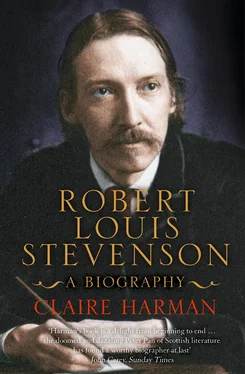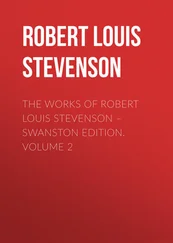Cummy was the type of servant who derived the keenest gratification from being indispensable, and turned down more than one suitor, it is said, to stay in the Stevensons’ service for twenty years. Her devotion to Lewis, intensified by his vulnerability and the emerging realisation that he was to be the Stevensons’ only child, went hand in hand with an equally powerful intention to mould the boy to her pattern. She could delight the child with her songs and dances and was selfless in the devotion of her time to his care (no trips to the bar for her, or even the usual nurse’s expedient of meeting with friends in the park). Her genuine interest in his company fed the child’s already pronounced egotism and her relation to him was – oddly enough – more that of companion than nanny, as Stevenson’s later description of her as ‘my first Wife’ would seem to corroborate.
In 1857 this compact household moved from Inverleith Terrace, which had proved damp and uncongenial, to a splendid house on Heriot Row in the heart of the elegant New Town, overlooking Queen Street Gardens from the south. Beyond the gardens, whose trees were only half-mature at this date, were the tall fronts of the houses on Queen Street and in the distance, beyond the great metal river of the railway line, the smoky wynds and tenements of the Old Town climbed towards the Castle. This was the view from Lou’s day and night nurseries on the top floor; Cummy’s room was at the back of the house on the same floor, with views, in clear weather, of the Firth and, distantly, the coast of Fife, her home. There was a wide landing, with other bedrooms and storerooms off, and then the grand spiral staircase running down the core of the house and lit from above by a large glazed cupola. As a student, Stevenson was to be grateful for the fact that the stairs were made of stone and made little or no sound when he crept past his parents’ bedroom on the first floor late at night.
Thomas and Margaret’s bedroom looked out to the back of the property and had a bathroom leading off it; at the front on the same level was the elegant drawing room, with its fireplace and recesses and twelve-foot-high windows looking out on the genteel greenery of the Gardens. Down the stairs again was the ground floor, with its high-ceilinged, panelled dining room and wide entrance hall. The kitchens and sculleries were in the basement, accessible to tradesmen by the area steps. Heriot Row was a truly substantial home, exuding an aura of wealth well-spent. Nobody seeing it could have the least doubt that the only son of the house was a privileged child.
Robert Louis Stevenson’s many autobiographical essays and memoirs leave vividly contrasting impressions of his childhood. On the one hand, it contained the idyllic pleasures described in essays such as ‘The Manse’ and ‘Child’s Play’ and poems such as ‘My Kingdom’ and ‘Foreign Lands’, on the other it was a time of chronic ill-health and piquant terrors. There is a temptation, given the subject’s own obsessive recourse to images and tropes of duality, and his ‘clinching’ creation of the Jekyll-Hyde poles, to see his life in terms of strong contrasts. But Stevenson was unusual – in those last days before Freud – in recognising not just the co-existence of states of mind (in childhood particularly), but their inextricability. The author of A Child’s Garden of Verses was to say of his own earliest memories, ‘I cannot allow that those halcyon-days or that time of “angel infancy” have ever existed for me. Rather, I was born, more or less, what I am now – Robert Louis Stevenson, and not any other, or better person.’ 28 The ‘good’ and ‘bad’ parts of his childhood could no more be pulled apart than could the child and adult self. In its puzzling variability and dizzying plunges into dark and light, life was all of a piece.
Looking back on his childhood when he was twenty-nine, Stevenson concluded that he had been ‘lovingly, but not always wisely treated’ by his parents. 29 In fact, there were aspects of his upbringing that seem not only ill-advised, but even dangerous. It is a minor mystery, for instance, how the frail little boy survived the custom of the time to seal up a nursery ‘almost hermetically’ 30 so that it was always draught-free (i.e. airless), or how he ever slept, given Cummy’s treatment for insomnia, which was to give the fretful child a soothing drink of strong coffee in the middle of the night. Fanny Stevenson retrospectively blamed her husband’s ‘feverish excitement’ as a child on the powerful drugs he was given during bouts of gastric fever, and the regular use of antimonial wine, which Margaret Stevenson’s doctor brother George later believed had ruined the boy’s constitution. These remedies were held to be sovereign by the parents, and if the child seemed overwrought they would sooner remove his toys or send his playmates away to calm him, than lower the doses of strong or inappropriate medicine.
Even his parents’ happy marriage was problematic, for, as Stevenson was to say memorably in his essay ‘Virginibus Puerisque’, ‘the children of lovers are orphans’. Margaret gave over much of the childcare to Cummy, not thinking any harm could come of it, the nanny being such a religious body. But the strength of Cummy’s religious views (possibly a source of mild amusement to her employers) made hers a very troubling influence. Cummy was a devout member of the Free Church, and far more stringent in her interpretation of doctrine than Lou’s Church of Scotland parents. The theatre was the mouth of hell, cards were ‘the Devil’s Books’ and novels (meaning romances) paved the road to perdition. She filled the little boy’s head with stories of the Martyrs of Religion, of the Covenanters and the Presbyters and the blood-drenched religious fundamentalists of the previous two centuries, stories that were rendered, confusingly enough, in highly dramatic style. (Stevenson later told Cummy mischievously that her declamations had sparked his own obsessive interest in the drama.) The Bible and the Shorter Catechism were to Lou what Mother Goose might have been to a luckier child, visits to the Covenanters’ graves in Greyfriars churchyard were the substitute for playing in the park, and though there was opportunity to read adventure stories, Cassell’s Family Paper and (clandestinely) bound copies of Punch downstairs, Cummy’s regime of spiritual education was based around Low Church tract-writers and theologians, ‘Brainerd, M’Cheyne, and Mrs Winslow, and a whole crowd of dismal and morbid devotees’, as Stevenson recalled about twenty years later.
Cummy had mutually respectful relations with her employers and was trusted implicitly, but her religious brainwashing of her charge clearly subverted their authority over him. She was a simple woman who undoubtedly meant no harm, but her anxieties about the religious liberalism of the household were always clear. The Stevensons gave dinner parties and were known to drink wine; Mrs Stevenson had been flagrantly evasive of the ban on Sunday recreation by sewing a little pack onto the back of Lou’s doll so that his game could pass as ‘Pilgrim’s Progress’. One of Stevenson’s early memories was of his nurse ‘comforting’ him at night by pressing him to her in a ferment of prayer for the souls of his parents, who had broken the Sabbath by playing a game of whist after dinner. The scene sounds ludicrous now, but to the child spelled eternal damnation for his mother and father. He was wound up to such a pitch that he sometimes thought none of them would be saved, for even Cummy had lapses: he remembers them both straining to make out the contents in the printer’s window of serial stories she herself had cut short on the grounds of them threatening to turn out to be ‘regular novels’.
Читать дальше












